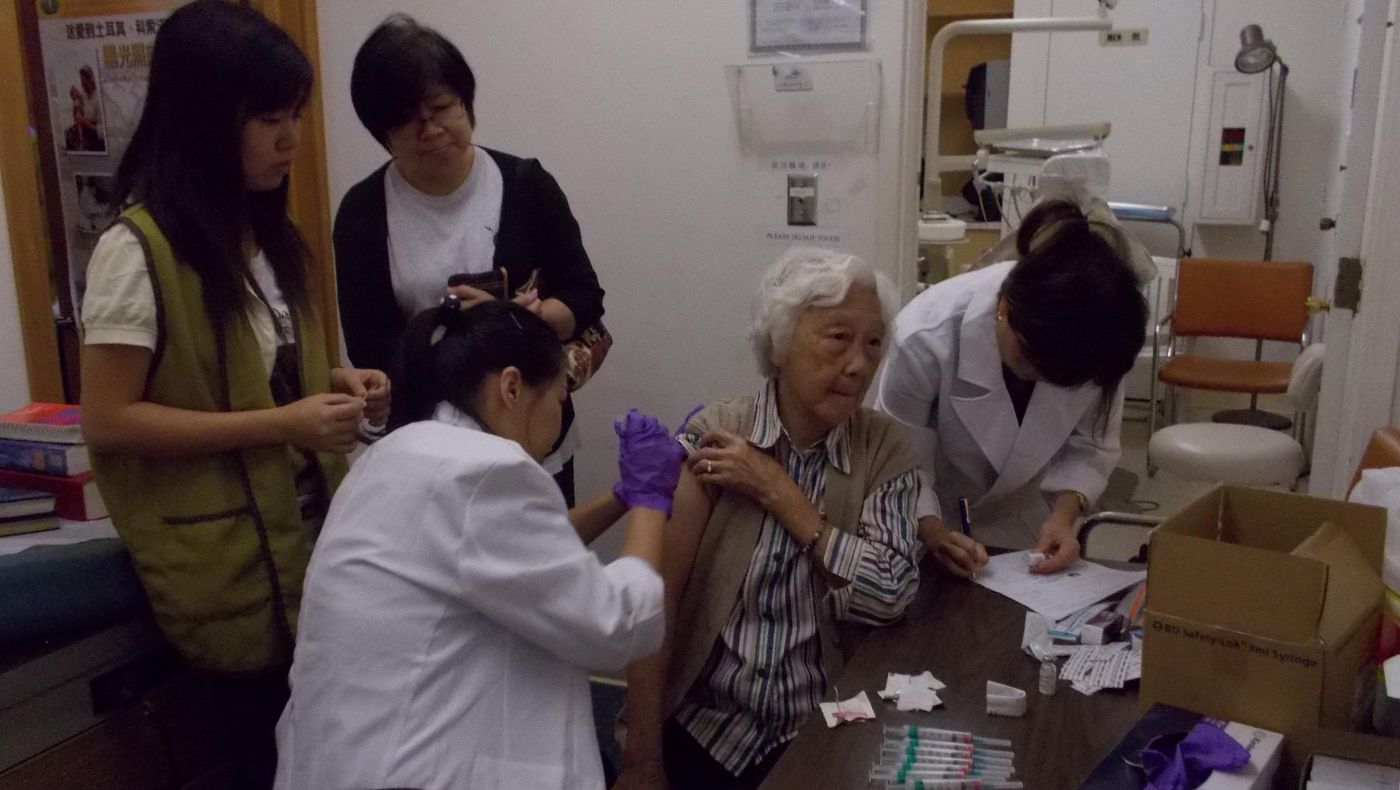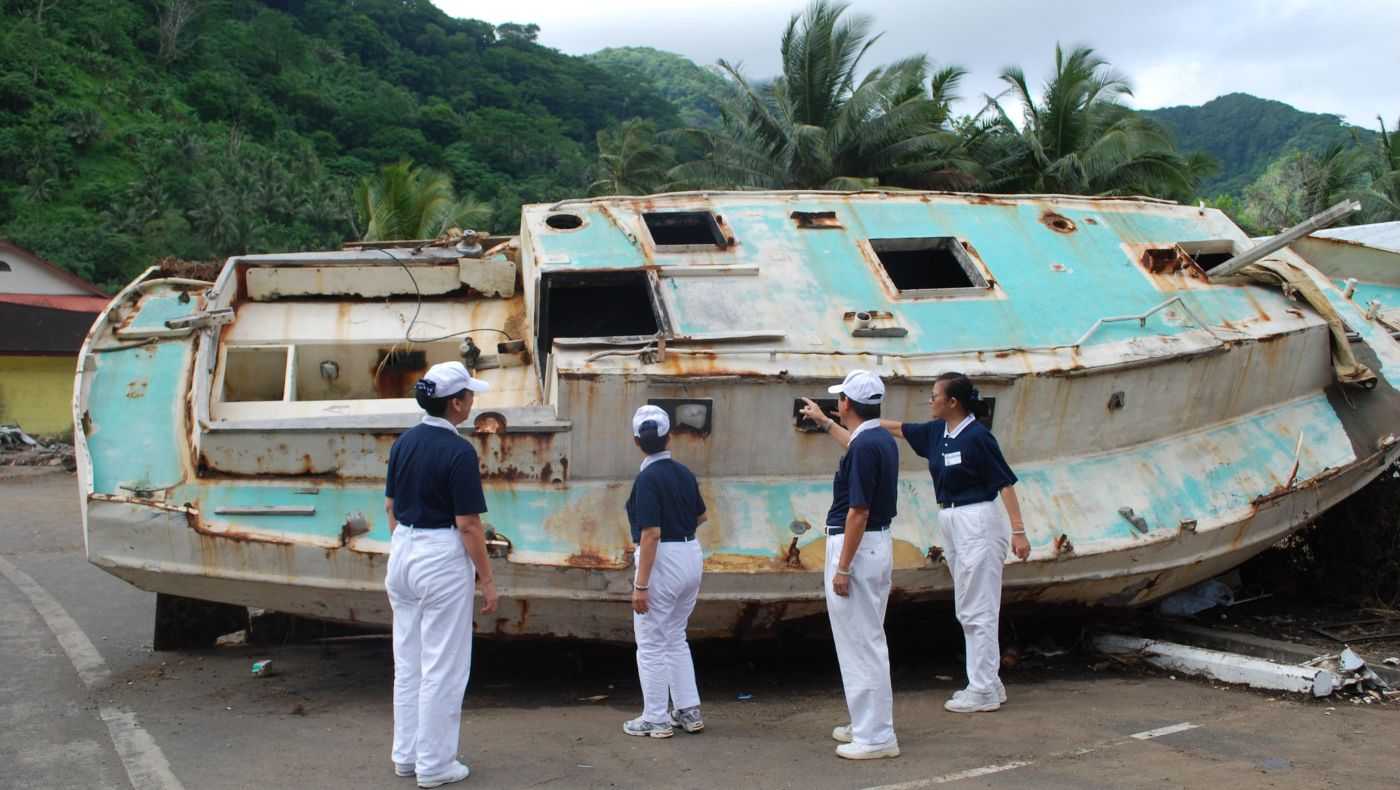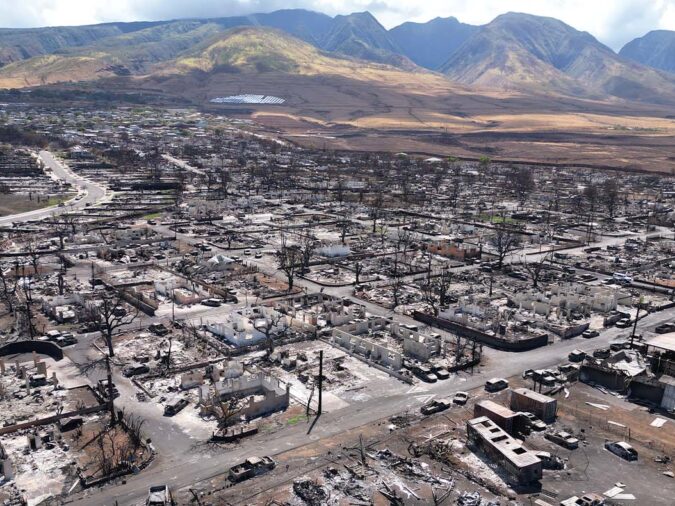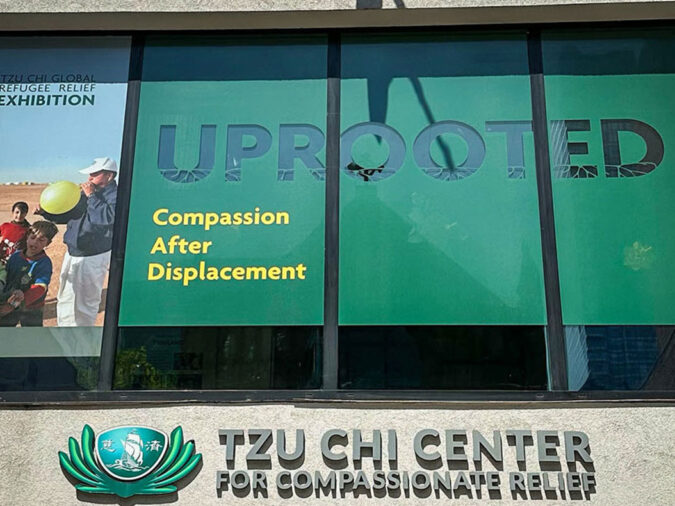CHAPTER 3
TIMA USA Pacific Islands
Written by Pheel Wang
Translated by Ariel Chan
Published #71 | Winter 2023 Issue


Micronesia lacks medical care. When a hurricane strikes in 2002, the health of South Pacific Islanders is a concern. Tzu Chi Hawaii volunteers brave the waves, taking fast boats to reach those impacted to distribute 850 family first-aid kits and 2,000 lbs of medicines. Photo/Tzu Chi USA Pacific Islands Region
SHARE
Hawaii is known for its perennial allure, a jewel among global destinations. Here, gentle breezes dance through swaying coconut palms, and pristine waves cradle nesting turtles along the shore. Its vibrant restaurants and bars teem with visitors, creating a lively tapestry of experiences. Bolstered by a thriving tourism industry, the median annual household income surged past $91,000 in 2022, securing Hawaii’s position as one of the nation’s top-earning states. Residents enjoy ample income and comprehensive health coverage, making it one of the healthiest states compared to other places.

However, this beautiful picture doesn’t belong to all islanders.
In the late 18th and early 19th centuries, Western colonialism made a forceful entry into the Hawaiian Islands, disrupting the millennia-old way of life of the Indigenous people. Their customary wholesome plant-based diet and self-reliance on agriculture crumbled. The introduction of Western processed foods, rich in calories but lacking in nutrition, along with the influx of meat, marked a significant shift.
Coupled with the challenges of grappling with Western languages and legal systems, Indigenous communities found themselves compelled to relinquish their ancestral lands. Western entrepreneurs swiftly transformed these lands into plantations, focused on sugarcane or specific cash crops destined for the global market. The once vital skills of harmonizing with nature – from farming to craftsmanship and even celestial navigation predictions – became obsolete in the face of land loss and technological intrusion.
Striving to seek new means of livelihood, yet constrained by language barriers, Indigenous communities found themselves marginalized on their own soil, grappling with an inability to be self-reliant and forced to lean on more affordable processed foods. With a diminishing agricultural labor force, owing to the loss of their land, a host of issues, from cardiovascular ailments and diabetes to obesity and even mental health challenges, as well as alcoholism, have permeated through the generations, persisting until the present day.
More than 15% of Hawaii’s Indigenous people don’t have health insurance, which is three times the national average. Over half of Hawaii residents are at risk of diabetes, while adolescents with mental disorders often can’t get the help they need.
2019 CHANGE Reports
Hawaii Business Magazine
Origins
Including Dr. Jerome Fan, Dr. Chang D. Lai, and others, many Chinese doctors and their families started a Tzu Chi base in Honolulu, O’ahu, Hawaii, in 1996. They adopted a beautiful name, “Heart Lotus Ohana” (Ohana means “family” in Hawaiian), to start serving low-income and uninsured island residents. In May 1997, they officially founded the Tzu Chi USA Pacific Islands Region chapter and established the Tzu Chi Free Clinic Center at its office.
“We have clinic hours from five to seven every Monday to Friday. Everyone knows that free clinics are a very good activity. When we see patients recover, we feel very happy and feel it’s worth it,” explained Dr. Fan, Executive Director of the Tzu Chi USA Pacific Islands Region at the time. He had not yet retired and performed kidney and organ transplant surgeries in the hospital during the day. Among the patients who came to his clinic were former Philippine presidents. But apart from work, Fan was busy with Tzu Chi affairs. “Going to free clinics was a way to relieve stress. Sometimes, I received thank-you cards from patients,” he recalled.


As soon as the Clinic opened, it covered various departments, including internal medicine, surgery, gynecology, pediatrics, cardiology, and allergy. It provided free medical treatment, medication, patient referrals, and counseling services regarding medical and insurance matters. The Clinic also regularly administered free flu shots for those in need.
On April 4, 1998, medical volunteers from various countries gathered in the Pacific Islands Region to discuss how to create a global medical network centered around the principle of compassion. In the same year, Tzu Chi International Medical Association (TIMA) was officially established, and the TIMA USA Pacific Islands Region chapter was born.
Small Teams Achieve Great Feats
The TIMA USA Pacific Islands Region chapter later began to engage in free clinic activities on several small islands in the Pacific from time to time. “When a tsunami hit (American) Samoa, Dr. Jerome Fan packed his bags and went. We went to Samoa three times,” recounted Tzu Chi Hawaii volunteer Stephanie Fan.
As American Samoa is a U.S. territory and doesn’t require visas or other procedures, in August 1998, Hawaii medical volunteers left the Big Island to extend their free clinic services to Samoa, a nearly six-hour flight away, for the first time, aiming to take care of the Indigenous peoples’ health. Five doctors and ten volunteers held Tzu Chi’s first clinic in Samoa on August 8 to 9, benefiting more than 700 people. The most common diseases there were high blood pressure, diabetes, and lymphatic filariasis, a tropical island disease also known as elephantiasis. This parasitic disease causes swelling, severe deformity, pain, and even disability in the affected areas.

In August 2003, a second free clinic service mobilized five doctors, two nurses, and 13 volunteers to provide outreach at the Lyndon B. Johnson Tropical Medical Center, Pago Pago in Tutuila. The team departed on the 1st and started a two-and-a-half-day clinic event on the 2nd, serving 1,000 people. In 2005, 16 people, including six doctors and ten volunteers, conducted a free clinic service from August 11 to 14.
Later, due to various circumstances, the team suspended follow-up clinic arrangements for Samoa. It wasn’t until September 29, 2009, when an 8.1-magnitude earthquake triggered a tsunami, causing nearly 200 deaths and destroying hundreds of houses, that they returned. Tzu Chi USA Pacific Islands Region volunteers set foot in Samoa again on October 3 to conduct a disaster assessment, bringing medicines and distributing cash card aid to 481 households, benefiting 1,968 people.

Whenever a large-scale disaster occurs, doctors from the TIMA USA Pacific Islands Region will mobilize and cross the sea to provide clinics in other places, such as Micronesia, Sri Lanka, and the Hurricane Harvey disaster area on the U.S. mainland. But they are also always on alert to serve in their region.
On August 8, 2023, the island of Maui in Hawaii experienced the deadliest wildfire to hit the U.S. in more than a century. Tzu Chi volunteers were on-site caring for the survivors through aid to soothe their material and emotional needs. At the same time, TIMA doctors were busy during the large-scale wildfire disaster relief distributions held in August and September 2023, bringing medicine and their services to help those affected physically and mentally.
Many survivors’ respiratory tracts were affected by the smoke, showing symptoms of asthma, so we gave them asthma medications. Many people’s blood pressure was high, also due to the impact of the disaster and emotions. We hoped we could reduce their mental pain, alleviate their tension, and, with medication, provide them with the best help.
Chang D. Lai
TIMA Physician
From Passive to Proactive
In 2010, then-U.S. President Barack Obama signed the Affordable Care Act into law, lowering the percentage of uninsured in Hawaii. Therefore, the Tzu Chi Free Clinic Center closed on January 31, 2016. However, the Tzu Chi USA Pacific Islands Region chapter remained active. Its volunteers even turned from passive to proactive, shifting from waiting for patients to come for treatment to actively promoting preventive medicine, helping vulnerable groups maintain physical, mental, and spiritual well-being. Through such efforts, they precisely responded to the loud call of former Hawaii Department of Health Director Dr. Virginia Presseler.


The biggest harm to Hawaiians is cigarettes, e-cigarettes, lack of exercise, excessive consumption of fast food and sugary drinks, which can lead to addiction, kidney disease, dialysis, cancer, and heart disease.
Dr. Virginia Presseler
Former Director
Hawaii Department of Health
The Community Wellness Program the Tzu Chi USA Pacific Islands Region created provides preventive healthcare lectures and free exercise courses to soothe the body and mind. It also collaborates with local media to regularly release vegetarian recipes, hoping that these preventive efforts, which are better than treatment, can gradually reconnect the traditions of coexistence with and nurturance of nature on these islands, revitalizing the holistic health that is all Pacific Islanders’ birthright.






























